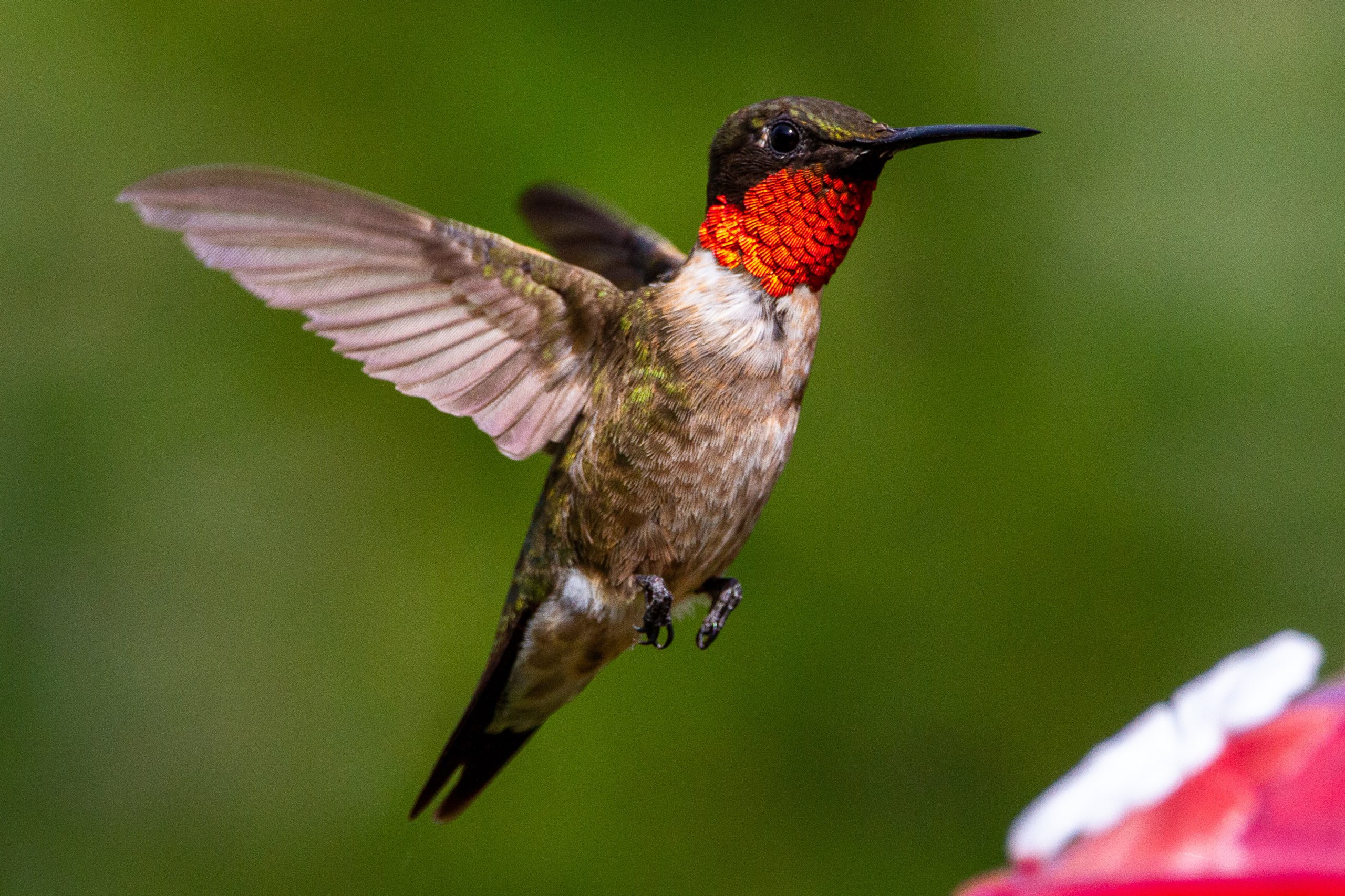With more than 330 different species, the hummingbird is one of a kind, with physical and behavioral characteristics that separate them from any other creature.
Hummingbirds and the Americas
Hummingbirds are only found in the Americas, and the majority of hummingbirds are only found south of the United States. Throughout South America, there is a wide variety of hummingbirds in each country, with Columbia boasting the greatest variety, at 165 different species.
Although not as widespread as in South America, there are a large number of hummingbirds that call Central America home. Costa Rica is the Central American hub for hummingbirds, with 54 different species.
Less than 20 species of hummingbirds call the United States home; only three of which can be found here in Florida.
Read on to learn more about our beautiful hummingbirds, or watch our “Wild Sarasota: Hummingbirds of Florida” webinar.
Iridescent, minute, and instantly recognizable

It’s possible to mix up one hummingbird species with another, but there is no mistaking that you have spotted a hummingbird once you’ve seen it. Distinct characteristics set this bird far apart from other bird species.
For starters, most hummingbirds are known for their unique, iridescent feathers. This iridescence is thought to be caused by melanosomes, a microscopic cellular component in their feathers. These flat, pancake-like cellular structures contain air bubbles, which reflect light in unique ways, leading to their beautifully bright coloration.
Hummingbirds are extremely small in comparison to other birds. Even their nests are tiny, many being the size of a thimble.
The smallest bird in the world is a hummingbird! The bee hummingbird (Mellisuga helenae), measures only 2.25 inches long and weighs less than 2 grams. The only way you can catch a glimpse of this tiny little hummer is if you head over to Cuba.

The bill of a hummingbird is long, thin, and the perfect tool to collect nectar from flowers and feeders.
The Sword Billed Hummingbird (Ensifera ensifera) is a particularly interesting example. In relation to its body size, this hummer has the longest bill of any bird in the world! Find this hummingbird in the tropical cloud forests of the Andes Mountains.
One can identify a hummingbird off its flight pattern alone! There are no other birds that can dart at such fast speeds, come to a halting stop, and hover in place for such long periods of time.
Fueling up with nectar …and more!
With a diet almost entirely dependent on nectar, these tiny wonders need to fuel up in order to beat their wings at speeds up to 80 beats per minute! Hummingbirds keep busy finding nectar from flowers and eating small invertebrates such as gnats, fruit flies, and spiders. Feeding every 10-15 minutes and visiting hundreds of flowers each day, they consume almost half their body weight daily!

If you’re looking to attract some hummingbirds to your backyard garden, here are a few Florida native plants that will help: firebush (Hamelia patens), crossvine (Bignonia capreolata), tropical sage (Salvia coccinea), and cardinal flower (Lobelia cardinalis). Learn more about gardening to attract hummingbirds.
Although nectar producing plants are the best food source for hummingbirds, a feeder can help provide some extra food for their diet. Fill up a feeder with sugar water, place it near your garden, and surely you will begin to attract some hummingbirds in your backyard. Use only white granulated sugar, as other additives and the molasses found in brown or raw sugar has elevated iron levels which can be toxic to hummingbirds. Don’t forget to clean and change your feeder regularly, and watch out for ants!
But beware, hummingbirds are quite feisty for how small they are, and some species more so than the other. Hummers will actively defend their flower or feeder; this can often lead to an entertaining chase.
Florida Hummingbirds
There are only three species of hummingbirds found here in Florida; the ruby-throated hummingbird, which is the most commonly seen, the black-chinned hummingbird and the rufous hummingbird.
The Ruby-throated hummingbird (Archilochus colubris)

- Adult males have an emerald to golden-green back and top of the head. Males also have iridescent, red plumage on their throat.
- The females do not have a red throat; it is, instead, white.
The Black-chinned hummingbird (Archilochus alexandri)

- Western hummingbird that winters in Mexico and along the Gulf of Mexico coast of Florida.
- This hummingbird is green on its back, and against its black chin is a small strip of purple which can only be seen in the right light.
- Males have a dull-gray to white underbelly and a velvet-black throat.
- Females are a dull-metallic green with a white throat and underbelly.
Rufous hummingbird (Selasphorus rufus)

- This hummingbird breeds farther north than any other hummingbird.
- Find them in California in the spring, Pacific Northwest and Alaska in the summer, the Rocky Mountains in the fall, and Mexico and Florida in the winter.
- Males are bright-orange on their back and belly, with an iridescent-red throat.
- Females have greenish feathers with rust-colored flanks, often with a spot of orange on the throat.
Learn More
- For all of your Florida wildlife interests, visit UF/IFAS Wildlife Page.
- Watch our Wild Sarasota webinar on Florida hummingbirds
- Further your Florida hummingbird knowledge with this UF/IFAS article.
- Get tips on gardening for hummingbirds and hummingbird feeders.
- Learn how to identify more hummingbirds at www.allaboutbirds.com
Read all our Wild Sarasota blogs HERE
 0
0
